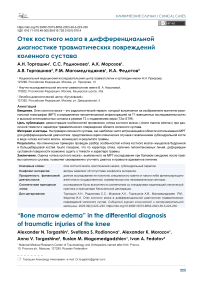Отек костного мозга в дифференциальной диагностике травматических повреждений коленного сустава
Автор: Торгашин А.Н., Родионова С.С., Морозов А.К., Торгашина А.В., Магомедгаджиев Р.М., Федотов И.А.
Журнал: Сибирский журнал клинической и экспериментальной медицины @cardiotomsk
Рубрика: Клинические случаи
Статья в выпуске: 3 т.38, 2023 года.
Бесплатный доступ
Введение. Отек костного мозга - это радиологический термин, который встречается на изображениях магнитно-резонансной томографии (МРТ) и определяется гипоинтенсивной инфильтрацией на Т1-взвешенных последовательностях и высокой интенсивностью сигнала в режиме T2 с подавлением жира (T2w-STIR).Цель публикации: демонстрация особенностей проявления «отека костного мозга» («bone marrow edema») при различной тяжести и характере травматического повреждения области коленного сустава.Материал и методы. На примере коленного сустава, как наиболее часто встречающейся области использования МРТ для дифференциальной диагностики, представлена серия клинических случаев с вовлечением субхондральной кости в виде «отека костного мозга», возникшего в результате травмы.Результаты. На клинических примерах проведен разбор особенностей «отека костного мозга» мыщелков бедренной и большеберцовой костей. Было показано, что по характеру отека, наличию гипоинтенсивных линий, деформации суставной поверхности возможно судить о тяжести и характере травмы.Заключение. Оценка «отека костного мозга», выявленного на МРТ исследовании при болевом синдроме после травмы коленного сустава, позволяет своевременно уточнить диагноз и провести адекватное лечение.
Отек костного мозга, асептический некроз, субхондральный перелом
Короткий адрес: https://sciup.org/149143643
IDR: 149143643 | УДК: 616.71-018.46-005.98:616.728.3-001]-079.4 | DOI: 10.29001/2073-8552-2023-39-3-223-230
Список литературы Отек костного мозга в дифференциальной диагностике травматических повреждений коленного сустава
- Nguyen U.S., Zhang Y., Zhu Y., Niu J., Zhang B., Felson D.T. Increasing prevalence of knee pain and symptomatic knee osteoarthritis: survey and cohort data. Ann. Intern. Med. 2011;155(11):725–732. DOI: 10.7326/0003-4819-155-11-201112060-00004.
- Azad H., Ahmed A., Zafar I., Bhutta M.R., Rabbani M.A., Kc H.R. X-ray and MRI correlation of bone tumors using histopathology as gold standard. Cureus. 2022; 14(7):e27262. DOI: 10.7759/cureus.27262.
- Hodgson R.J., O’Connor P.J., Grainger A.J. Tendon and ligament imaging. Br. J. Radiol. 2012;85(1016):1157–1172. DOI: 10.1259/bjr/34786470.
- Berger A. Magnetic resonance imaging. BMJ. 2002;324(7328):35. DOI: 10.1136/bmj.324.7328.35.
- Eustace S., Keogh C., Blake M., Ward R.J., Oder P.D., Dimasi M. MR imaging of bone oedema: mechanisms and interpretation. Clinical. Radiolol. 2001;56(1):4–12. DOI: 10.1053/crad.2000.0585.
- Smith R. Publishing information about patients. BMJ. 1995;311(7015):1240–1241. DOI: 10.1136/bmj.311.7015.1240.
- Filardo G., Kon E., Tentoni F., Andriolo L., Di Martino A., Busacca M. et al. Anterior cruciate ligament injury: post-traumatic bone marrow oedema correlates with long-term prognosis. Int. Orthop. 2016;40(1):183–190. DOI: 10.1007/s00264-015-2672-3.
- Sanders T.G., Paruchuri N.B., Zlatkin M.B. MRI of osteochondral defects of the lateral femoral condyle: incidence and pattern of injury after transient lateral dislocation of the patella. AJR. 2006;187(5):1332–1337.DOI: 10.2214/AJR.05.1471.
- Viana S.L., Machado B.B., Mendlovitz P.S. MRI of subchondral fractures: a review. Skeletal. Radiol. 2014;43(11):1515–1527. DOI: 10.1007/s00256-014-1946-y.
- Ochi J., Nozaki T., Nimura A., Yamaguchi T., Kitamura N. Subchondral insuffi ciency fracture of the knee: review of current concepts and radiological diff erential diagnoses. Jpn. J. Radiol. 2022;40(5):443–457. DOI: 10.1007/s11604-021-01224-3.
- Gorbachova T., Melenevskky Y., Cohen M., Cerniglia B.W. Osteochondral lesions of the knee: Diff erentiating the most common entities at MRI. Radiographics. 2018;38(5):1478–1495. DOI: 10.1148/rg.2018180044.
- Mink J.H., Deutsch A.L. Occult cartilage and bone injuries of the knee. Detection, classification and assessment with MR imaging. Radiology. 1989;170(3 Pt. 1):823–829. DOI: 10.1148/radiology.170.3.2916038.
- Miller M.D., Osborne J.R., Gordon W.T., Hinkin D.T., Brinker M.R. The natural history of bone bruises. A prospective study of magnetic resonance imaging-detected trabecular microfractures in patients with isolated medial collateral ligament injuries. Am. J. Sports Med. 1998;26(1):15–19. DOI: 10.1177/03635465980260011001.
- Vellet A.D., Marks P.H., Fowler P.J., Munro T.G. Occult posttraumatic osteochondral lesions of the knee: prevalence, classification and shortterm sequelae evaluated with MR imaging. Radiology. 1991;178(1):271–276. DOI: 10.1148/radiology.178.1.1984319.
- Bretlau T., Tuxøe J., Larsen L., Jørgensen U., Thomsen H.S., Lausten G. Bone bruise in the acutely injured knee. Knee Surg. Sports Traumatol. Arthrosc. 2002;10(2):96–101. DOI: 10.1007/s00167-001-0272-9.
- Maraqhelli D., Brandi M.L., Matucci Cerinic M., Peired A.J., Colagrande S. Edema-like marrow signal intensity: a narrative review with a pictorial essay. Skeletal. Radiol. 2021;50(4):645–663. DOI: 10.1007/s00256-020-03632-4.
- Zanetti M, Bruder E, Romero J, Hodler J. Bone Marrow Edema Pattern in Osteoarthritic Knees: Correlation between MR Imaging and Histologic Findings. Radiology. 2000;215(3):835–840. DOI: 10.1148/radiology.215.3.r00jn05835.
- Accadbled F., Vial J., de Guazy J.S. Osteochondritis dissecans of the knee. Orthop. Traumatol. Surg. Res. 2018;104(1S):S97–S105. DOI: 10.1016/j.otsr.2017.02.016.


